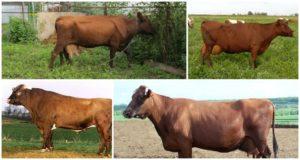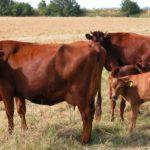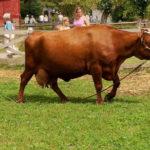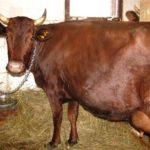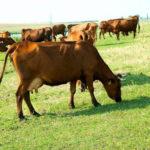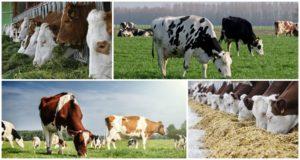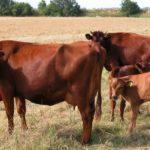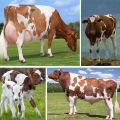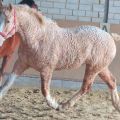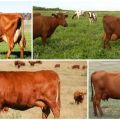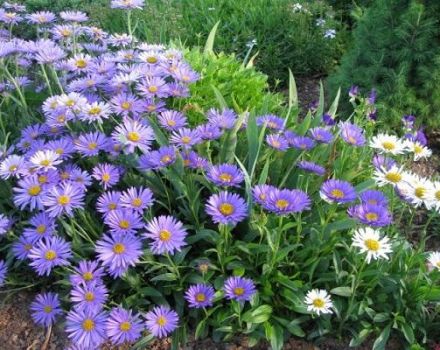Description and characteristics of red Danish cows, their content
To increase the productivity of animals, breeders are constantly engaged in breeding new breeds and improving existing ones. This is especially important for farmers involved in the production of meat and milk, as these products are in high demand among consumers. For these farmers, breeding a highly productive red Danish breed of cows is considered a safe bet.
Breeding history
This breed is a representative of the dairy and meat and dairy trends in animal husbandry, the origins of which go back to the 18-19 centuries, when Danish peasants crossed local cattle with the Angler, Ballum, North Schleswig, Shorthorn breeds.
Red Danish is considered as one of the branches of the Scandinavian massif of red dairy breeds, which also includes the Norwegian and Swedish, close to the Finnish Ayrshire.
How the breed developed
The Angler breed is considered the first link in the development of the Danish cow. To increase the mass, improve external data, she was crossed with Shorthorn bulls. Half of the animals born from them were mixed with highly pedigree Danish bulls. As a result, the red Danish cow acquired a solid physique, powerful muscles, began to weigh more, and give more milk. Thus, one of the most productive dairy cattle breeds in the world was obtained, which breeders are still working on, trying to improve it.
Red Belarusian cattle are also being improved by crossing with Danish. And this is being done for the second time: it was first practiced in the 1920s and 1930s. Then the red Belarusian was improved due to the infusion of blood from the red Polish and Danish breeds, later they began to cross with the red Estonian, brown Latvian. In recent years, there has been a new infusion of red Danish blood.

Characteristics and appearance of the breed
The Danish breed is characterized by a beautiful color, in which shades of red vary from lighter to darker. Some individuals are marked with white spots on the belly and udder. These are large cows, at the withers they reach 130 cm and weigh 550-800 kg. The constitution is medium, the body is deep, wide, the legs are short and massive. The width of the thoracic region is 43 cm, the back part is 55 cm.
Body description:
- light head on a thin elongated neck;
- gray nasal mirror;
- the back is straight and wide with a sagging lower back;
- massive dewlap.
They are distinguished by developed muscles and skeletal system, the skin is thin and elastic. The udder is large, round or bowl-shaped, the nipples are cylindrical. A distinctive feature is the increased milk flow rate, which increases the overall productivity.
Productivity reaches 9000 kg per lactation. In the composition of milk, the protein content reaches 3.2-3.5%, fats - from 3.9 to 5%, which exceeds the same indicators in the Holstein-Friesian breed. These cows are distinguished by excellent meat qualities, therefore animals that are not suitable for milk production are fattened.
Slaughter meat yield reaches 57-59%. They gain weight quickly, weight gain - 1.4 kg per day.
Pros and cons of the red Danish cow
They quickly reach maturity, are distinguished by increased meat and dairy productivity (up to 9000 liters), and are unpretentious. The peculiarity of these animals is a cheerful, friendly, active character.

Maintenance and care of animals
The red Danish breed is unpretentious, easily adapts to different conditions, however, in order to maintain proper productivity, proper body weight, it is important to observe certain conditions:
- Optimal indoor temperature. It should be warm so that the cow does not waste the body's reserves on heat exchange, which significantly reduces her productivity.
- Lack of drafts (cause illness, inhibit weight gain).
- Purity. It is important to remove manure regularly.
- Permanent access to water.
- The room is well ventilated, especially in summer.
The red Danish cow does not like hot climates, so in the summer you need a constant supply of fresh air. On grazing, a shady place is selected to protect from the sun during the hot season, and also provide access to water.
Features of the diet
The cow's diet should be complete and balanced. Hay and green grass are considered its basis, which are supplemented with silage, concentrates, root crops. Before daily walking, the cow is fed 2-3 kg of straw, this prevents gas formation.
When fattening animals for meat, it is necessary to ensure:
- grain - up to 45% of the diet;
- bran - 14-16%;
- sunflower cake - 30%;
- corn - 7%;
- mineral additives - 7%.
With the arrival of spring until the end of autumn, the cow is grazed. This increases productivity as well as the rate of weight gain. With a lack of greenery in the pasture, they give concentrates, root crops.

Breeding specifics
A young Danish cow is ready to hunt at the age of 12 months, but early mating adversely affects the further development of females, so farmers take measures to ensure that the first calving occurs at the age of two.
Childbirth is quick and easy: from 30 minutes to one hour. Pregnancy lasts 295 days. In the prenatal and postpartum periods, the cow needs a favorable temperature regime. Development features:
- the weight of calves at birth is 33-37 kg, they are characterized by increased vigor: they gain 1200-1400 g per day;
- the weight of a one-year-old replacement bull - 420 kg;
- the weight of full-grown cows - up to 800 kg, bulls - up to 1000.
The red Danish breed is used for purebred breeding, as well as for re-crossing with individuals derived from it.
Frequent illnesses
Cows of this breed are resistant to diseases, have good immunity, and have strong hooves.To maintain health, regular vaccinations are carried out, the first at eight days of age.
Animals are resistant to mastitis, but it is necessary to express milk in a timely manner in order not to cause this disease. For preventive purposes, animals are given a lick containing the required set of minerals.
On the territory of our country, the red Danish breed has gained great popularity. Large and small farms gladly breed it. Under favorable conditions of keeping and feeding, young animals show increased growth vigor, and adult cows - excellent productivity and fertility.
